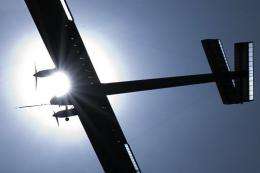The Solar Impulse aircraft, a pioneering Swiss bid to fly around the world on solar energy takes off in April 2010 from Payerne's air base, western Switzerland.
The prototype of a pioneering Swiss bid to fly around the world on solar energy aims to take to the skies on Thursday in the first attempt at a night flight fuelled by the sun, the team said.
The high-tech single-seater Solar Impulse aircraft, with the 63.40-metre (208-foot) wingspan of a large Airbus A340 airliner, plans to take advantage of clear summer weather to take off from Payerne airbase in western Switzerland, it said.
"The situation continues to look good and the likelihood of seeing the HB-SIA take off on July 1st and land back in the early morning July 2nd is increasingly probable," it said in a statement Tuesday.
Team members have said they need a 25-hour window of clear and calm summer weather to attempt the pioneering round-the-clock flight above Switzerland and eastern France.
Pilot Andre Borschberg plans to keep the aircraft at altitudes of up to 8,500 metres, storing some of the energy from solar panels in batteries during the daylight to fly through the night before landing after dawn on Friday.
Despite its huge wingspan, the aircraft only weighs about as much as a family-sized car, about 1,600 kilogrammes (3,500 pounds).
"We're not sure to make it at the first try, let's be clear about this," said Solar Impulse president and founder Bertrand Piccard, the round-the-world balloonist.
The solar venture has grown in recent months, joined by former space shuttle astronaut Claude Nicollier and retired NASA chief test pilot Rogers Smith.
The prototype made its 10th test flight under solar energy on Tuesday. It first hopped off a runway shortly after it was unveiled seven months ago.
Powered by four 10 horsepower electric motors -- each about as strong as the engine that took the Wright Brothers into the air more than 100 years ago -- Solar Impulse's take-off speed is just 35 kilometres per hour (22mph), with a cruising speed barely twice as fast.
The prototype is slightly smaller than the craft that is planned to fly around the world in 2013 to 2014.
(c) 2010 AFP
























